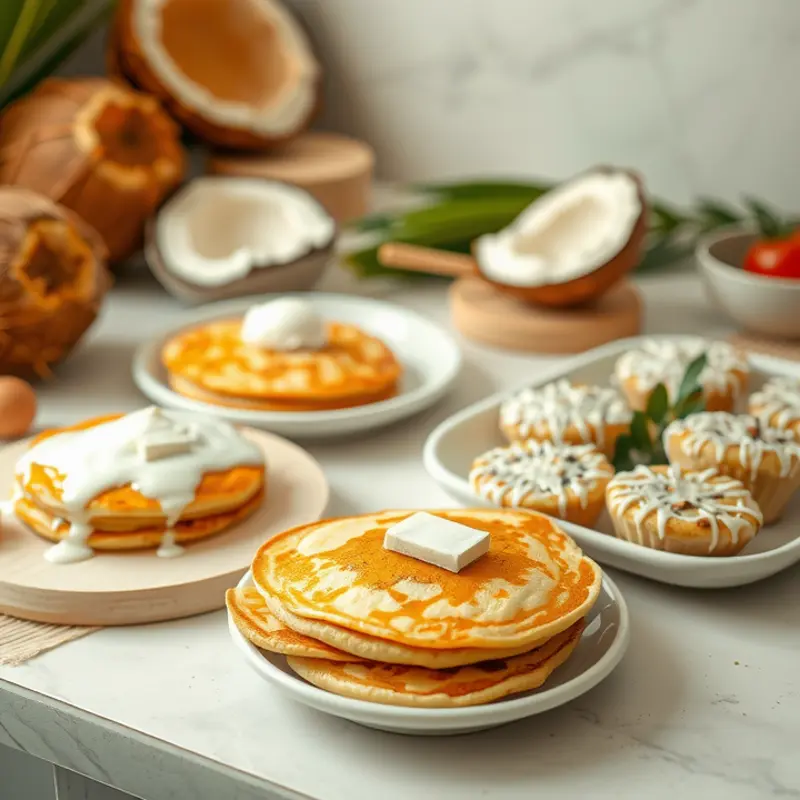Coconut flour is gaining traction among home cooks who seek healthy alternatives to traditional flours. Naturally gluten-free and rich in fiber, it opens diverse culinary possibilities. Understanding how to cook with coconut flour empowers dietary-conscious cooks to make healthier choices in their kitchens, providing the balance between taste and nutrition. This guide offers practical insights, easy substitutions, and flexible solutions for incorporating coconut flour into your everyday cooking.
Coconut Flour Essentials: What You Need to Know

Coconut flour has an unmistakable charm due to its unique traits and nutritional profile. Derived from the meat of mature coconuts, it’s a naturally gluten-free and low-carb alternative to traditional flours. Among its many benefits, coconut flour boasts a high fiber content, contributing to digestive health and helping to maintain healthy cholesterol levels. Its low glycemic index makes it an appealing choice for those managing blood sugar levels.
One of the key nutritional highlights of coconut flour is its fiber-rich nature. Just two tablespoons of coconut flour provide approximately 5 grams of dietary fiber, enhancing satiety and aiding digestion. This high fiber content means that coconut flour absorbs more liquid than all-purpose or whole wheat flour. Therefore, when substituting coconut flour for other types, adjustments in liquid ratios are essential to avoid creating excessively dry or dense baked goods.
When using coconut flour, a general rule of thumb is to use about a quarter of the amount of coconut flour compared to grain-based flours. Additionally, increase the liquid content by adding more eggs or a plant-based alternative, as coconut flour’s density and absorption capacity can affect the final texture of the dish. For example, using one egg for every 30 grams of coconut flour in recipes is a common practice to counteract its dryness.
Beyond baking, coconut flour lends itself well to savory cooking. Its subtle sweetness pairs famously with herbs and spices, making it suitable for breading or as a thickening agent in soups and sauces. Understanding these properties can transform your dishes with minimal effort, as indicated in this guide to ingredient substitutions, which highlights flexibility and creativity in the kitchen.
Proper storage of coconut flour is crucial to maintain its freshness and nutritional value. Like many flours, coconut flour is prone to absorbing odors and going rancid if not stored correctly. The best practice is to keep it in an airtight container in a cool, dry place, away from sunlight. When stored correctly, coconut flour has a shelf life of up to one year. However, for maximum flavor retention, it’s often recommended to use it within six months.
Awareness of the coconut flour’s essential characteristics can transform your culinary endeavors. Whether enhancing a traditional recipe or experimenting with new ideas, understanding how to handle coconut flour efficiently is crucial. As you experiment with coconut flour, you’ll appreciate its ability to balance healthful eating with innovative cooking, making it a staple worth exploring in your kitchen adventures.
Practical Substitutions and Recipes for Coconut Flour

Coconut flour opens a world of culinary possibilities, offering a high-fiber, gluten-free alternative for various dishes. It’s essential to understand the unique characteristics of coconut flour to achieve great results. One of the key things to remember is that coconut flour absorbs more liquid than traditional flours. Typically, you’ll use about 1/4 to 1/3 cup of coconut flour for every cup of regular flour you replace. Additionally, adding extra eggs or other binders is often necessary to maintain structure in your recipes.
When starting with breakfast recipes, coconut flour pancakes make an excellent choice. Mix 1/3 cup of coconut flour with four eggs, 1/2 cup of almond milk, and a touch of vanilla extract for a deliciously light breakfast option. These pancakes are not only nutritious but also cater to a variety of dietary restrictions.
Muffins are another delightful way to use coconut flour. To replace traditional flour, use 1/4 cup of coconut flour, add three eggs, and ensure the batter is well hydrated. Complement the muffins with fruits like blueberries or apples for added flavor and moisture. Be prepared for a denser texture that will have a subtly sweet taste, thanks to the natural sweetness of coconut flour.
Pasta, although unconventional with coconut flour, can be satisfying when mixed with other gluten-free options like almond or rice flour. A simple ratio to follow is one part coconut flour to two parts of another gluten-free flour. These combinations yield a supple pasta dough, perfect for those craving noodles without the gluten guilt.
For those inclined towards savory dishes, coconut flour can be integrated into batter for frying or as a thickener for soups and sauces. When breading meats or vegetables, mix coconut flour with herbs and spices for added flavor. The coating offers a slight sweetness with a crispy finish when fried, adding depth to each bite.
Adapting recipes can be made easy by blending coconut flour with compatible flours such as oat or chickpea flour. This mix not only complements the coconut flavor but also improves the consistency and structure of the dish. For those exploring gluten-free cooking, a deeper understanding of cooking without gums can vastly expand culinary capabilities as well (explore this guide for more insights).
Cooking with coconut flour encourages the discovery of new taste profiles and textures that contribute to a satisfying and nutritious diet. The unique qualities of coconut flour demand a degree of creativity and flexibility. Remember to experiment and adjust as you become familiar with this delightful and versatile ingredient.
Final words
Coconut flour is an exciting ingredient that invites creativity in the kitchen. Its unique properties and nutritional benefits make it an excellent choice for home cooks striving for healthier meal options. Experimenting with coconut flour not only enhances your cooking repertoire but also supports a gluten-free lifestyle. By understanding how to use coconut flour effectively through practical tips and a variety of recipes, you can elevate your dishes while nourishing your body. Start incorporating coconut flour into your diet today, and enjoy the flavorful and healthy dishes you can create.







